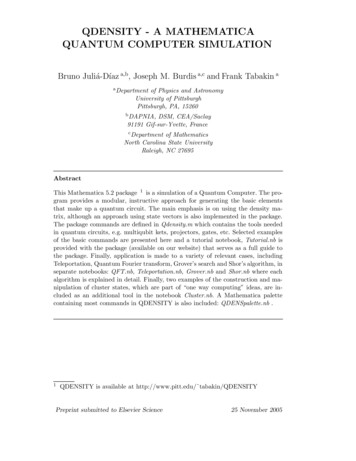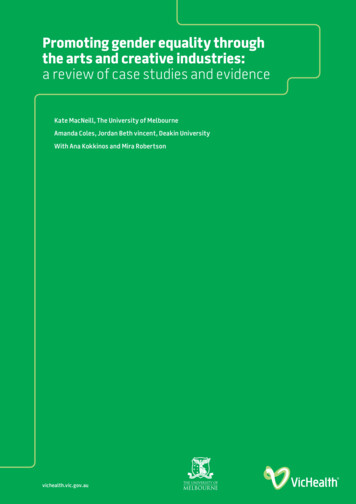
Transcription
Supporting and Promoting High-PerformingPhysician-Owned Private Practices: Voicesfrom the Front LinesWhite PaperOctober 22, 2021Diane Rittenhouse, Tiffany Olszuk, Margaret Gerteis, Jan Genevro, Katie Hancock,Evelyn Li, Lindsey Carlasare, Carol Vargo, and Kathleen BlakeThe American Medical AssociationProfessional Satisfaction and PracticeSustainability300 N. Wabash Ave., Suite 39300Chicago, IL 60611Mathematica505 14th Street, Suite 800Oakland, CA 94612-1475Phone: (510) 830-3700
ContentsI.Introduction . 1II.Methods . 2A.Sampling strategy . 2B.Recruitment and participating practices. 3C. Interview approach . 6D. Data analysis . 6E.Limitations . 6III. Findings . 7A.Overview of high-performing private practices. 7B.Advantages of private practice . 12C. Threats to private practice . 13D. Looking forward. 20IV. Implications for Research, Training, Policy, and Practice . 22A.Health services researchers . 22B.Professional organizations, ACOs, and IPAs. 22C. Medical educators or accreditation organizations . 23D. Policymakers. 23V.Conclusion . 25References . 26ExhibitsII.1Practice sample selection process. 3II.2Summary of practice recruitment by practice specialty and size . 5II.3States represented in the sample of high-performing physician-ownedprivate practices . 5Mathematicaii
I. IntroductionI feel like they could be doing more to help the independent groups We are still a big partof health care out there. I mean I know we’re sort of a dying breed, and some people look atus as kind of like a zebra that, you know, is not gonna be around much longer but we are avery good example of how this type of a setup can be successful. I just think they shouldrecognize that independent groups are still viable. We’re still important.— Physician from a medium-sized multispecialty practice in the MidwestPhysician-owned private practices, once the norm in the United States, are becoming less common.American Medical Association (AMA) survey data from 2020 confirmed a persistent downward trend inthe percentage of physicians working in physician-owned practices, although it remains high at 49.1percent, confirming the importance to the U.S. health system of this model of care and suggesting thatextinction of this model would be highly disruptive (Kane 2021). The remaining private practices faceimmense administrative, financial, and clinical challenges in a predominantly fee-for-serviceenvironment.A large body of research demonstrates that independently owned physician practices represent a distincthealth care delivery model with specific advantages and disadvantages (Cuellar 2018). For example,evidence suggests that, compared with hospital-owned practices, physician-owned practices might beslower to adopt innovations such as health information technology (Rittenhouse et al. 2017) and caremanagement processes (Rittenhouse et al. 2011). Yet total spending and quality measures—such aspreventable hospital admissions, readmissions, and emergency department visits—for physician-ownedpractices are equivalent to or better than other models of practice (Burns et al. 2018; Casalino 2014;Casalino et al. 2018; Goldsmith et al. 2015; McWilliams et al. 2013; Pesko et al. 2018; Post et al. 2017;Whaley et al. 2021; Young et al. 2021; ).In this report, we describe findings from a qualitative study Mathematica conducted with the AMA todefine, analyze, and assess the factors that create and sustain high-performing, physician-owned privatepractices. First, we describe our sampling strategy, recruitment, and interview approaches. Then, wedescribe our findings, which include (1) the nature of high-performing practices, (2) the advantages ofprivate practice, (3) the threats and challenges associated with private practice, and (4) an overview of thechanges physicians see coming to their practices in the future. We conclude with implications forresearch, training, policy, and practice.Mathematica1
II. MethodsA. Sampling strategyWe employed a purposive sampling approach to identify practices for recruitment. A purposive sample isa nonprobability sample selected using expert opinion based on the characteristics of a population and theobjective of the study. Researchers who determine the parameters of the study select key informants andseek out people who will provide the information by virtue of knowledge or experience (Bernard 2001).This approach allows for identifying and selecting information-rich cases related to the subject of interest(Palinkas et al. 2015). Our sampling strategy consisted of the following steps:1. Identify a pool of high-performing practices. We identified a pool of high-performing practicesusing the 2017 Physician Compare Downloadable Databases, which are publicly available data setson the Centers for Medicare & Medicaid Services website. We started with the Physician CompareNational Downloadable File, which contains general information about individual clinicians,including demographic characteristics, address, phone number, specialty, and name of affiliated grouppractice. Because we were interested in small and medium-sized physician practices, we excludedpractices with more than 15 physicians and practices composed entirely of non-physician clinicians.Next, we identified high-performing practices based on the 2017 Merit-Based Incentive PaymentSystem (MIPS) final score for groups.1 In performance year 2017, the score comprised threeperformance categories: (1) quality, (2) improvement activities, and (3) advancing care information(now known as promoting interoperability). Individual clinicians or groups with a MIPS Final Scoreof 70 points or higher (out of 100 points) were eligible for positive payment adjustments for anexceptional performance bonus. More than 700,000 physicians participated in MIPS reporting in2017 and avoided a negative payment adjustment, and 44 percent of practices with 15 or fewerclinicians scored in the exceptional range (Navathe et al. 2019). Following the MIPS scoringmethodology, we defined high-performing practices as those with a MIPS score of 70 or above.2. Exclude system-owned practices. We excluded system-owned practices from the pool of highperforming practices using data from the 2016 Compendium of U.S. Health Systems. Publiclyavailable from the Agency for Healthcare Research and Quality, the compendium database provides apractice identifier linkable to Physician Compare data and an indicator for whether health systemsown the practice as of December 31, 2016. The compendium database defines a health system toinclude at least one hospital and at least one group of physicians providing comprehensive care thatare connected with each other and with the hospital through common ownership or joint management.After completing the first two steps, we identified 3,526 high-performing candidate practices that had 15or fewer physicians and were not owned by health systems (Exhibit II.1).1The 2018 MIPS performance data were not available at the time of this study.Mathematica2
Chapter II MethodsExhibit II.1. Practice sample selection processSample selection stepPhysician Compare National Downloadable FileExclude large practices and non-physician practicesNumber of practices1,136,84137,076Limit to MIPS Final Score 703,778Exclude system-owned practices3,526MIPS Merit-Based Incentive Payment System.3. Determine desired mix of practices. We stratified the pool of candidate practices to determine thedesired mix of practice sizes and specialties. Size. We stratified the sample into solo (1 physician), small (2 to 5 physicians), and medium (6 to15 physicians) practices. We chose to study small and medium-sized practices (1-15 physicians)because they represent the majority of independent practices in the United States and likely facedifferent challenges compared to large practices (Casalino et al. 2016; Khullar et al. 2018). Inaddition, physicians in small- and medium-sized practices are more likely to be directly involvedin the practice’s operations and business than are physicians in larger practices with more than 15physicians. Specialties. We focused on four common specialties: (1) primary care, (2) multispecialty, (3)cardiology, and (4) general surgery. We define a practice as primary care if all of its physicianswere in either family medicine or internal medicine. We define a practice as multispecialty if itincludes other specialties beyond family medicine and internal medicine, and at least one-third ofits physicians are in family medicine or internal medicine.Based on the stratified analysis, we determined a purposive sample consisting of 3 solo practices, 11small practices, and 11 medium practices with the expectation that the number of practices in each sizegroup might vary depending on the recruitment outcome. Within each size-specialty stratum, weprioritized practices that would help evenly cover all four U.S. Census regions (Northeast, South,Midwest, and West). We also considered rural locations (defined by the Federal Office of Rural HealthPolicy) to ensure a balanced sample of practices from rural and urban areas. To account for refusal toparticipate and nonresponse, we identified backup candidates for recruitment across the size-specialtystrata and rank ordered them to prioritize those that exhibit characteristics of most interest to the study.B. Recruitment and participating practicesStarting with the 25 high-priority practices in our purposive sample, we used online searches andinformational telephone calls to identify the medical director or most senior clinician in charge at eachpractice. After identifying the physician leader from each practice, we initiated formal outreach via aletter of invitation describing the purpose and objectives of the research, its voluntary and confidentialnature, the reasons for our interest in their practice, and terms of participation. We offered 300compensation as an incentive to participate in a one-hour telephone interview. We followed up with eachpractice by phone until we determined the practice was ineligible for the study (n 4), it accepted ourinvitation to participate (n 25), or it declined to participate (n 8). The study director also categorizedsome practices as dead leads (n 20) after calling multiple times with no response.Mathematica3
Chapter II MethodsWe recruited 25 practices to participate in the study and interviewed 25 physicians from 24 practices. Wecould not interview one medium-sized cardiology practice because of challenges the practice facedrelated to the COVID-19 pandemic. In total, we interviewed 3 solo practices, 7 small practices, and 15medium practices. Exhibit II.2 summarizes our outreach efforts to practices and shows the total number ofparticipating practices by specialty and practice size. In all, 12 of the 24 practices were in primary care, 3were multispecialty, 3 were in cardiology, and 6 were in general surgery. In addition, 8 of the 24 practiceswere in rural areas. The participating practices spread across 20 states (Exhibit II.3).Mathematica4
Chapter II MethodsExhibit II.2. Summary of practice recruitment by practice specialty and sizeExhibit II.3. States represented in the sample of high-performing physician-owned privatepracticesMathematica5
Chapter II MethodsC. Interview approachBetween September and December 2020, Dr. Rittenhouse and Dr. Gerteis conducted one-hour virtualinterviews with each participating physician-leader, and a research associate took notes.For each interview, we used a uniform semi-structured discussion guide covering topics such ascharacteristics of the practice, its patients, and the market; business operations and management; approachto quality improvement and quality management; practice culture and leadership; and factors contributingto the sustainability of high-performing physician-owned private practice (see Appendix B for discussionguide).We audio-recorded all interviews except one to supplement detailed handwritten notes, and all audiotapes were professionally transcribed.D. Data analysisWe analyzed interviews using a conventional approach to content analysis to identify emergent themes.We coded transcripts independently without the use of qualitative software. Subsequently, members ofthe Mathematica research team met regularly to reach consensus on topics, identify discrepancies, refineconcepts, and develop emerging themes. Quotes provided in this report exemplify these themes.E. LimitationsBecause this is a qualitative study with a small purposive sample, some findings might not begeneralizable to all independent physician-owned primary care, multispecialty, or general surgerypractices. In addition, we used MIPS scores to identify high-performing practices. MIPS scores are oneindicator of performance but might not reflect all aspects of quality that are important to understandinghigh-performing practices. For example, MIPS scores might not accurately capture a practice’s officeculture. Some practices might institute policies or initiatives that go beyond what MIPS requires, andothers aim to meet the minimum requirements for a positive payment adjustment. Finally, the MIPS scorefile that we used to select high-performing practices for the sample was from 2017. Although these datawere the most recent information available to the public at the start of the study, a few of the practices inthe sample might no longer meet the MIPS score criteria for a positive payment adjustment.Mathematica6
III. FindingsHere, we report the findings from our interviews with physician leaders of 24 high-performing physicianowned private practices across the country. In each section, we include a sample of exemplar quotes fromphysician leaders to further illustrate key findings.A. Overview of high-performing private practices1.High-performing private practice is not one size fits allGovernance structure and staffing models varied widely across practices, and no single model emerged asa best practice. Practices grew organically over time, and key decisions about governance structure andstaffing models were largely personality-driven or specific to time and local geographic and marketcontext. One key driver of high performance was choosing physician partners.a.Governance structures varied widelyThe governance structure varied widely across practices. For example, some practices had partnershiparrangements in which all partners had an equal voice and input in decision making, and others hadformal leadership roles with the equivalent of positions such as chief executive officer, chief financialofficer, chief operating officer, or chief information officer. Many practices assigned leadership roles tophysician partners based on their existing skill sets. A few practices had rotating leadership structures orother arrangements such as contracts with management entities to hire and manage office staff. In allpractices, physician partners met regularly to discuss administrative, clinical, and financial matters,though the frequency of these meetings and attendees at the meetings varied. For example, some partnersmet twice per month with only physician partners, and some met weekly with administrative staff.We all play a part in managing, discussing, and deciding on everything from new equipmentto purchase to whether we should build an office, to whether we should cover this hospital orthat hospital. So, no one in particular has any more power than others from a votingstandpoint. And we will defer to each other—for example, I do a lot of the [informationtechnology], networking, computing, and management, so some of the others will defer tome. And I will defer, for example, the financial aspects to those who are more interested andtalented in that region and so forth. Everything is voted on pretty flatly at this point by the sixof us.— Physician from a medium-sized cardiology practice in the WestWe have a very talented [chief executive officer] who is very involved with the variousorganizations and medical management He’s still beholden to the eight partners, but hehas a fair amount of autonomy in what he does in the practice. And yeah, he’s been terrific.He’s been with us for three or four years now. We’ve had shifts in the senior managementteam as far as practice managers, and our [chief executive officer] as the practice hasgrown, and revenue has increased. We needed people with enhanced experience incomputer and revenue stream, and the financial aspects of the practice.— Physician from a medium-sized cardiology practice in the WestWe do something that we’ve been told by a number of consultants can’t work except it doeswork. Forever, we were a three-headed hydra with one of us managing [human resources],another managing the physical plant, and I managed the fiscal plan. And it worked. And weMathematica7
Chapter III Findingscould fight with each other, we could scream at each other, we could curse. And then wecould go play golf and go drink a beer together. And that worked. And as we grew, weestablished more roles for more people that we brought in. And now all partners in thepractice are part of the management team.— Physician from a medium-sized primary care practice in the NortheastSo, we have the luxury of being best friends, additionally, which is a huge blessing in ourlives in a difficult job and world. We probably talk a couple times a day and we operatetogether when we can, and we just talk things through and figure it out. There’s no formalstructure, I would say that I take the lead in the practice. I’m just a little more type A.— Physician from a small general surgery practice in the MidwestMany physicians emphasized that selecting physician partners for the practice is one of the mostimportant contributors to running a successful private practice. Several compared the partnershipdynamics to a marriage, and many emphasized the need to hire physicians who see the practice as a longterm commitment.The four of us are not best friends, but beginning a practice is like a marriage. So, you haveto be as honest as you can and communicate with each other. You don’t have to like eachother really well. You just have to work together. And I think that’s worked for us to that weunderstand each other’s pros and cons, we work within those constructs.— Physician from a small family medicine practice in the MidwestFinding the right person is the hardest thing, I think, in running a practice. The right personthat’s going to come and stay and be a 22-year employee and be there for the duration It’ssuper expensive when a doctor or a surgeon comes to a practice and then leaves—for bothsides. You’re covering their overhead for quite a while before they’re productive enough tocover their own overhead. So, you want them to be successful.— Physician from a medium-sized general surgery practice in the Midwestb.Staffing models varied widelyMost physicians said that they had low physician turnover in their practice. On the other hand, physicianssaid that medical assistants and front-office staff tended to turn over more frequently.I think when you can have a private practice like ours, where we have people who [have]good business minds but still are concerned about providing care for people first and makingpeople feel like they’ve received good care and they’ve had compassionate care, if peopleare part of something like that, I think it makes them want to stay in a place like this.— Physician from a small multispecialty practice in MidwestThey’re my family. I mean it—not blood, but I treat them as family. We have great workingconditions, we have a great environment—just physically, emotionally, mentally. I treat themwell financially. You know, I’ve had good mentors in the past, and they said if you’re going tobe successful or good, you surround yourself with good and successful people So, wesurrounded ourselves with excellent staff, nursing staff, billing staff, secretarial staff, andwe’re just one happy family. I have never fired one person in my office. And very proud tosay that.— Physician from a small general surgery practice in the NortheastMathematica8
Chapter III FindingsAlmost all practices, regardless of specialty, employed advanced practice providers, such as nursepractitioners and physician assistants, but their roles in each practice differed. For example, some roundedon patients in hospitals, nursing homes, or outpatient settings, and others managed wound or walk-inclinics. The nursing staff in each practice also differed. Most practices employed licensed vocationalnurses, but one employed only registered nurses. Some larger practices had the capacity to supportadditional staff, such as health educators, social workers, and dieticians.Larger practices had dedicated business management staff, which enabled physicians to focus more onclinical care.So, the administrative team, obviously, they kind of oversee the day-to-day operations interms of the finances and the money coming and going and so forth, so, we’re, you know,for the most part, able to focus on our medical practices.— Physician from a medium-sized multispecialty practice in the MidwestHowever, in solo and small practices, physicians tended to take on more administrative responsibilities.You’re everything. You’re the provider, you’re the physician, you’re the manager, you’re thehuman resource person, you’re the computer technician. Everything falls on your head — Physician from a small family medicine practice in the SouthThere’re a few little things that you’d need almost an admin for, but we’ve just really pickedthose up. We just do them. So, we open the mail, and we do a few little things here andthere.— Physician from a small general surgery practice in the Midwest2.High-performing private practice means delivering high quality health care and running asuccessful businessNearly all private practice physicians we spoke to indicated that, to them, high performance meanssimultaneously delivering high quality health care and running a successful business.a.Delivering high quality health care means excellent physicians and excellent outcomesNearly all interviewees placed strong emphasis on the excellence of the individual physicians in theirpractice. Excellence was described in a traditional qualitative sense: using informal assessment of clinicaljudgement by their physician colleagues; establishing a reputation in their community; getting along wellwith physicians, staff, and patients; and going the extra mile for patients by, for example, activelytracking down lab results and being accessible to their patients. Excellence was also measured moreformally using available data on clinical standards and outcomes of care.I think that independent practice.really is driven by quality providers. If you have providerswho care about providing for people, they’re mindful of the business side of it. And hopefully,they’re mindful of the business side of it because they realize that’s a means to an end ofproviding better care.— Physician from a small multispecialty practice in the MidwestTo be successful as a private practice surgeon, you have to be skilled and have goodrapport with patients and physicians, so your practice grows. Whereas that is not necessarilyas important if you’re in an owned practice where you have a guaranteed feeder source, andMathematica9
Chapter III Findingsthe administrator is telling their primary care doctors they have to refer their patients to thisgroup of doctors because they own them.— Physician from a medium-sized general surgery practice in the MidwestWe’re extremely patient-centered, extremely available, hiring the best doctors we could hire,and practicing the standards. We expect everybody to meet the standard of care. The worldof medicine now actually tells you what you have to do. It no longer accepts the idea thatyou’re a physician and you absolutely know what you’re doing. And so, there really is astandard of care for A1C, there really is a standard of care for blood pressure, there really isa standard of care for immunizations. We’ve always demanded that of ourselves.— Physician from a medium-sized family medicine practice in NortheastAll physicians indicated that the fee-for-service environment does not provide direct financial motivationfor high quality care. Instead, physicians expressed personal and professional motivations for deliveringhigh quality care, such as being seen as the go-to practice for other physicians in the area and doing whatthey think is best for patients, physicians, and society.Success is also determined on how we are viewed in the community, in terms of ourreputation there, how our patient outcomes are We ended up taking on and investing thetime in creating a mission statement, vision, values, and posting those so people knew thatwe wanted to have this be our corporate culture, so to speak. We’ve taken intentional stepsto make sure that people know our practice.— Physician from a medium-sized primary care practice in the Midwest[A successful private practice physician is] someone whose primary motivator is notmoney. You can definitely make a very comfortable very good living, being in solo orprivate practice, but if your primary motivator is doing something for the revenue stream, Ithink you’re gonna get burned. [The important] criteria: Is it good for the patient? Is it goodfor the provider? Is it good for society? I think [you’ve] got to follow those rules.— Physician from a solo practice in the Southb.Running a successful business requires market knowledge, strategy, and change managementPhysicians also described how running a successful business requires an understanding of the local healthcare market and strategic management to adapt to changes in the marketplace. Several physiciansemphasized the need to pursue innovation and be on the leading edge of technology, especially in relationto using electronic health records (EHRs) to their full capabilities and managing the data necessary tosupport quality-based payments.Have a strategic plan, have a business model. Follow that through, but also be nimbleenough to course-correct. What we’ve learned is, you can’t force something to happen,sometimes you have to react to what comes at you in this type of business rather than tryingto make things happen themselves, but I think for private practices, practice groups, theyneed to have a strategy. They need to have a good business plan and a good businessmodel to succeed.— Physician from a medium-sized general surgery practice in the WestI think to be successful, you have to be adapting to the environment as it’s occurring, orbetter yet predicting where you think things are going to be.— Physician from a medium-sized primary care practice in the MidwestMathematica10
Chapter III FindingsWell, the first thing is I would say is let technology be your friend. Try not to hate yourEHR, but make the EHR work for you. So, one would just realize that the world is techietoday, so, you know, deal with it, cope with it, just push that angle and then align yourselfwhether it’s an [accountable care organization] or [clinically integrated network] or some ofthese other [entities] because I think going forward you’re going to have to have[technology and relationships with networks] if you want to keep shared savings or capitationor these per member per month payments. Fee-for-service I think, is going away, andhonestly, it probably does need to go away. So, you’re going to have to be able to get thosesavings to stay in business.— Physician from a small primary care practice in the SouthYou must be adaptable to the point of being ahead of change. Stress of the [electronicmedical record], value-based care, quality improvement.a lot of them couldn’t adapt [to]those changes, and they had to sell or close. Some are able to adapt to changes.— Physician from a small prima
Physician Compare National Downloadable File 1,136,841 Exclude large practices and non-physician practices 37,076 Exclude system-owned practices 3,526 MIPS Merit-Based Incentive Payment System. 3. Determine desired mix of practices. We stratified the pool of candidate practices to determine the desired mix of practice sizes and specialties.










